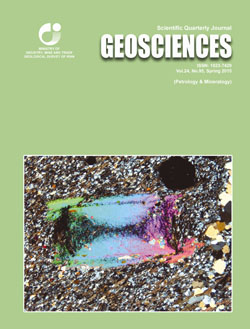Document Type : Original Research Paper
Authors
1 Assistant Professor, Department of Geology, Payame Noor University, Iran
2 Associate Professor, Department of Geology, Shahid Bahonar University of kerman, kerman, Iran
Abstract
The Bidkhan stratovolcano in the southeast of Urmia-Dokhtar volcanic belt (Kerman province) contains complex successions of lava flows and pyroclastic deposits. It belongs to Miocene-Pliocene periods and so, its edifice is relatively intact. Therefore, it is a suitable target for volcanic facial studies. Facies analyses showed that the Bidkhan structure could be divided into four facies. The Central Facies is located in the Bidkhan caldera and contains the special lithological units such as altered subvolcanic intrusion, lava breccias and radial and circular dykes. The Proximal Facies has been developed around the caldera as elevated steep cliffs and clearly shows stratification. In this facies, there are thick successions of lava flows, and pyroclastic fall, flow and surge deposits. The most voluminous facies in Bidkhan is Medial Facies. It is mainly consists of numerous layers of pyroclastic deposits and lava flows along with the lahars. Thin Bidkhan Distal Facies contains the coarse-grained alluvial deposits that have been formed due to reworking of primary volcanic products by streams. Facies analyses showed that the Bidkhan volcano has been formed by several explosive eruption phases and some eruptions have been done in the presence of water. Features such as strong welding and color of pyroclastic deposits indicate that the volcanic products formed in high temperature subaerial conditions. The Bidkhan Central Facies can be suitable place for Cu-Mo porphyry exploration.
Keywords

